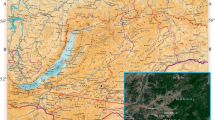Abstract
Investigations of changes in the soil and plant covers is necessary when designing technical objects—gas and oil pipelines, highways, and power lines—in order to avoid the adverse effects of these activities and to preserve vulnerable northern ecosystems. Recent changes in the soil–plant cover of the High Arctic of Eastern Siberia are directed towards its higher complexity. Chaotic bare stone debris evolve into stony polygons with “soil embryos” and patchy vegetation. Recently deglaciated areas are locally overgrown with plants on weakly developed soils of the initial stage of pedogenesis and then evolve towards the stage of mosaic plant cover with tonguing (glossic) soils. At the next stage, soil–plant complexes are formed with a continuous plant cover on soddy arctic soils. Melt water of glaciers and snow fields saturate the sediments and may induce their textural differentiation. Soil and plant cover changes in the areas with ice wedges have their own specificity. Ice wedges are typical of floodplains, where they form tetragonal complexes of moss or moss–grass tundra with gleyzems and peat soils on tops of the wedges. After the cessation of floods, ice wedges tend to degrade, and small lakes are formed in their places. Bogged tetragons are replaced by the mesophilic forb–grass tundra with gleyic soils. Under conditions of good drainage, this stage is followed by the stage of baydzharakh terrain. When the baydzharakhs are destroyed, a hummocky grass–forb tundra with soddy tundra soils appears.






Similar content being viewed by others
REFERENCES
V. D. Aleksandrova, Arctic Tundra of the USSR (Leningrad, 1964), pp. 1–40.
V. D. Vasil’evskaya, Pedogenesis in Tundra of Central Siberia (Nauka, Moscow, 1980) [in Russian].
B. N. Gorodkov, “Specific features of soil cover in the Arctic,” Izv. Gl. Geofiz. Obs., No. 19, 1516–1531 (1939).
B. N. Gorodkov, “Soil-plant complexes of tundra and polar-desert landscapes,” in Proceedings of Second Geographical Congress (Geografgiz, Moscow, 1949), Vol. 3, pp. 84–92.
S. V. Goryachkin, Soil Cover of the North (GEOS, Moscow, 2010) [in Russian].
E. N. Ivanova, “Systematics of Soils of the north of the European part of the USSR,” Pochvovedenie, No. 1, 3–15 (1956).
N. A. Karavaeva, Tundra Soils of Northern Yakutia (Nauka, Moscow, 1969) [in Russian].
L. L. Shishov, V. D. Tonkonogov, I. I. Lebedeva, and M. I. Gerasimova, Classification and Diagnostic System of Russian Soils (Oikumena, Smolensk, 2004) [in Russian].
A. V. Lupachev and S. V. Gubin, “Role of pedogenesis in formation of the transient layer of permafrost,” Kriosfera Zemli 12, 75–83 (2008).
A. V. Lupachev, S. V. Gubin, and M. I. Gerasimova, “Problems of the cryogenic soils’ diagnostics in the recent Russian soil classification system,” Eurasian Soil Sci. 52, 1170–1175 (2019). https://doi.org/10.1134/S1064229319080106
N. S. Mergelov, S. V. Goryachkin, I. G. Shorkunov, E. P. Zazovskaya, and A. E. Cherkinsky, endolithic pedogenesis and rock varnish on massive crystalline rocks in East Antarctica, Eurasian Soil Sci. 45, 901–917 (2012).
I. S. Mikhailov, “Soddy Arctic soils of the Bol’shevik Island,” Pochvovedenie, No. 6, 24–30 (1960).
I. S. Mikhailov, “Soils of polar deserts and studies of B.N. Gorodkov,” Izv. Vses. Geogr. O-va 94, 520–523 (1962).
I. S. Mikhailov, “Evolution of soils and vegetation cover in the northeastern part of the Fadeevskii Island,” Tr. Arkt. Antarkt. Nauchno-Issled. Inst. 224, 121–131 (1963).
I. S. Mikhailov, “Soils,” in Soviet Arctic (Nauka, Moscow, 1970), pp. 230–246.
Z. M. Prik, “Climate fluctuations in the Arctic and their reasons,” Tr. Arkt. Antarkt. Nauchno-Issled. Inst. 228, 43–51 (1968).
C. Bay, “Floristical and ecological characterization of the polar desert zone of Greenland,” J. Veg. Sci. 8 (5), 685–696 (1997).
N. Fedoroff, Les Sols du Spitsberg Occidental (Centre National de la Recherche Scientifique, Lyon, 1964).
A. E. Foscolos and H. Kodama, “Mineralogy and chemistry of Arctic desert soils on Ellef Ringnes Island. Arctic Canada,” Soil Sci. Soc. Am. J. 45, 987–993 (1981).
I. C. F. Tedrow and D. E. Hill, “Arctic brown soils,” Soil Sci. 80, 88–108 (1955).
Author information
Authors and Affiliations
Corresponding author
Additional information
Translated by D. Konyushkov
Rights and permissions
About this article
Cite this article
Mikhailov, I.S. Changes in the Soil-Plant Cover of the High Arctic of Eastern Siberia. Eurasian Soil Sc. 53, 715–723 (2020). https://doi.org/10.1134/S1064229320060083
Received:
Revised:
Accepted:
Published:
Issue Date:
DOI: https://doi.org/10.1134/S1064229320060083




